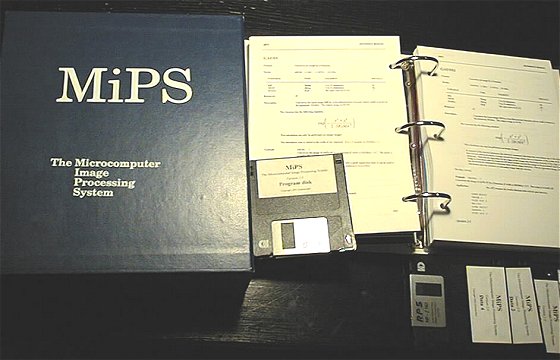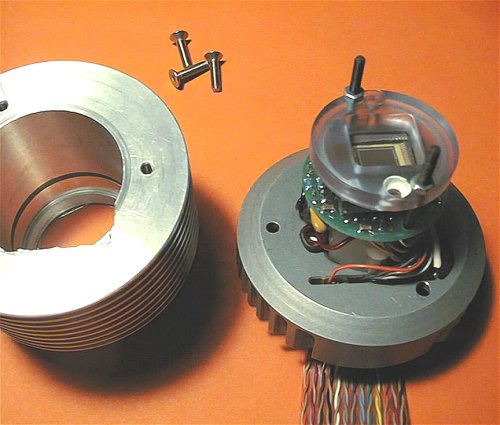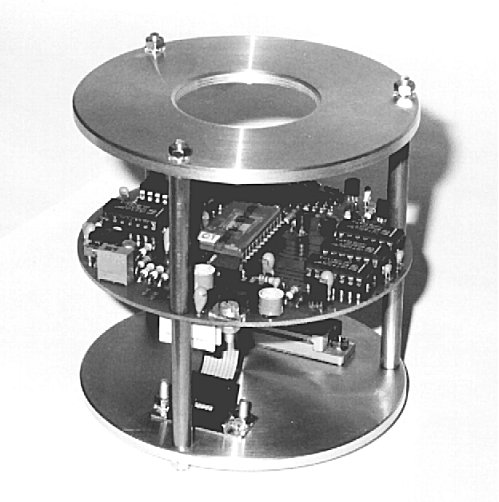PART 5: 1990-1997

The year 1990 was also the year of the first discovery of a supernova by amateurs with a CCD camera. SN1990N was found by Eric Thouvenot, Guylène Prat and myself in the course of an observing run on the 24” with a camera based on the Thomson TH7863 chip. It was a veritable revelation: one could therefore make discoveries with a CCD camera!

Thereafter at the Pic, the refrigeration bucket, here hanging from the track of the 24” telescope’s dome, was assigned a new function: to keep a good bottle of Champagne well chilled – just in case!

After years of using the famous M.A.T. (image acquisition) and T.I. (image processing) programs, it became urgent to develop an image processing program that was worthy of the name. The task really began in 1990, and after three years of work the program MiPS (“The Microcomputer Image Processing System”) and its 600 page documentation were offered to amateurs.

This camera, built around the Thomson TH7852 chip in 1990, has a particular significance. That was the first time that all the camera’s electronics were integrated onto a single printed circuit board. Until then one had to connect a number of components with numerous cables. This was the prototype of a project which has remained extremely confidential: The Small Astronomical Camera. The idea is to disseminate plans throughout the amateur community which will permit one to build a CCD camera as inexpensively as possible (here, here!). Everything contributes toward that end: the miniaturized electronics, the molded plastic case, the ease of use, etc. A DB25 connector provides direct connection to your computer’s parallel port. One DB9 connector serves as a feed, and another as an expansion port. It was, you might say, the Audine camera 10 years before its time! Note on the side of the lid (at left) a black extrusion: that is a bicycle inner tube valve, used to inject Nitrogen gas into the camera to keep it from frosting when it is cooled. You can also see, on the same side of the lid, a gas purge port closed by a valve-screw and cap.

In 1991, a camera well ahead of its time was built around a CCD chip that was large by the standards of the day, the Thomson TH7895M. That detector already integrated MPP technology (meaning that it could operate above 32° F. with acceptable darks for short exposures), and had a 10×10 mm imaging area (512×512 pixels of 18µ). Overall, its degree of integration was extremely high, since the CCD was cooled by a Peltier module and the critical clock chips were contained in a case only three inches in diameter, cooling fins included. The rest of the electronics were contained in a box smaller than a pack of cigarettes. Unfortunately that camera has not been followed up on. It was at least five years in advance of the comparable American commercial product, and even today it is still nothing to sneeze at.

In 1992 the idea was born to launch a society which would fabricate inexpensive CCD cameras for amateurs. That society continues to increase in its impact, and is known as “LE2IM”. I do not participate administratively in the life of that society, but I do serve it as an advisor. I recommended that they begin with a very simple and inexpensive camera which I could make in 2 or 3 weeks. Thus the Hi-SIS11 came into being. Its performance was modest, and the user had to complete it with mechanical parts of his own device (as only the two metal rings were supplied), but it was super-easy to use. It worked perfectly with (4) 4½ volt batteries. The chip used is a Thomson TH7852. The Audine project is a direct descendant of the Hi-SIS11.

Then in 1992, while working on a high-performance model based on the TH7863 chip, I discovered by chance the existence of the KAF-0400 CCD chip, by Kodak. It hit me like a thunderbolt! I then began a new project using the KAF-0400, which resulted in a camera well-known in France: the Hi-SIS22. In this photo you see the first prototype of the Hi-SIS22, which was relatively close to the final version. Note particularly the two valves on the side for cooling by water. Franck Vaissière, current treasurer of the AUDE Association, performed the mechanical fabrication of this prototype. This was the first time that the KAF-0400 had been used in a camera for the amateur astronomer. Shortly thereafter, Gilles Révillon took sole control of LE2IM’s destiny, and I distanced myself from that society.

It became clear very quickly that the characteristics of the KAF-0400 were remarkable, even using small telescopes. Here the impacts of SL-9 on Jupiter are observed with only a 5” telescope (July 1994): that was a lesson that would be retained for the list of requirements for the Audine CCD camera.

This is Alain Klotz and myself beside the dome of the 24” telescope at Pic du Midi, observing the impacts of SL-9 on Jupiter in July 1994. Take one CCD camera, a good red filter, and a correctly oriented polarizing filter, and you can do astronomy day and night! Our only serious problem was trying to see anything on our computer monitor in the brilliant sunshine of the Pic; that was a challenge!

Before the advent of the current Audine camera, a few new developments were made in the realm of a minimalist camera which runs itself. Here is a prototype of the SW11, developed around the KAF-0400 during 1996.

Upon mature reflection, it became clear to me that it was necessary to impart a certain professionalism to the development of the camera which was to become the Audine. It is only by putting together in common our numerous different competencies that one can win the battles of performance and of cost. On 23 August 1997 I invited the Toulousan staff members of the AUDE Association to join me around a table. Everyone agreed to embark upon this adventure with me. I found in them a surprising commitment to labor heavily on this vision. A year and a half later, the Audine system first saw light of day.